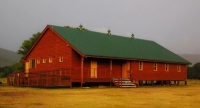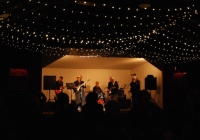Grasses
Tropical grasses are excellent as a pasture grasses but also can be serious environmental weeds. Their height, density and rate of growth can cause serious changes to our environment. Already in the northern Territory, the increase of gamba, mission and panic grasses represent the greatest threat to native plant communities. Soils can suffer long term nutrient loss when tropical grasses are burnt. Their fast, strong growth requires more nutrients from the soil, which is lost to the atmosphere if burnt.
Setaria – Setaria Nandi
This tropical clump forming pasture grass has displaced Kikuyu as the dominant tropical grass on unmanaged land in parts of the valley. It is fast growing, hardy and seeds well; luckily the seed does not persist for long. Small trees can be smothered by its strong lush growth. This also increases the fire risk in dry times as a result of increased fuel loads. Bees can gain some nectar from the flowers. Not good fodder for horses as extended grazing on Setaria pasture can cause horses to develop Big Head. Symptoms appear as affected gait, poor performance and swelling of bones of the head. Big Head is the result of a calcium imbalance that occurs when horses graze exclusively on grasses containing high levels of oxalate. Setaria has the highest level of oxalate amongst the introduced pasture grasses
Elephant, Bana Grass or Cow Cane – Pennisetum purpureum (POACEAE)
Native to Africa. This grass is spreading down the range section of the Obi Obi Rd towards the Obi Obi Valley. Forms bamboo-like (4 metre high), densely tufted clumps that invades bushland vegetation
Guinea grass – Panicum maximum)
Green panic – Panicum maximum var. trichoglume
 A 3 metre tall clumping perennial grass from Africa. This grass is already in the Mapleton end of the valley. It is attractive to seed eating birds such as Bronze Mannikin
A 3 metre tall clumping perennial grass from Africa. This grass is already in the Mapleton end of the valley. It is attractive to seed eating birds such as Bronze Mannikin
Giant rat’s tail (GRT) grass – Sporobolus pyramidalis and S. natalensis
May causes losses in animal carrying capacity and may decrease production by up to 80%. This unpalatable tough grass can loosen the teeth of cattle and horses while grazing. May causes losses in animal carrying capacity and may decrease production by up to 80%. This grass was originally introduced unintentionally into Queensland around the early 1960s in contaminated pasture seed.
Giant rat’s tail grass is a Class 2 declared plant under Queensland legislation.
Parramatta grass – sporobolus africanus
Parramatta grass has the same characteristics as Giant rat’s tail grass. Both of these Sporobolus grasses are being aggressively combated by farmers in the valley.
Parramatta grass is a declared Class 2 plant under Queensland legislation.
Broad Leaf Paspalum – Paspalum mandiocanum
Now a naturalized pasture grass. origionally from South America
Shade loving thick smothering grass which will overpower all in it’s path
See the pages below for information on
1 – Home. 2 – Vines. 4 – Herbs. 5 – Ground covers. 6 – Bulbs.
7 – Shrubs. 8 – Palms. 9 – Trees. 10 – Aquatic plants.









